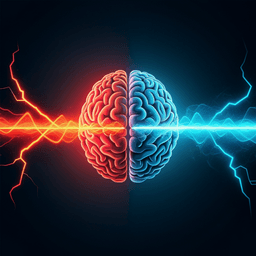
Psychology
Distributed neural representations of conditioned threat in the human brain
Z. Wen, E. F. Pace-schott, et al.
Combining fMRI data from 1,465 participants with multivariate pattern analysis, this study establishes reproducible distributed neural decoders that sensitively and specifically distinguish threat from safety across diverse paradigms, merging classic 'threat circuit' regions with sensory and cognitive nodes. Research conducted by Zhenfu Wen, Edward F. Pace-Schott, Sara W. Lazar, Jörgen Rosén, Fredrik Åhs, Elizabeth A. Phelps, Joseph E. LeDoux, and Mohammed R. Milad.
~3 min • Beginner • English
Introduction
The classical 'threat circuit'—including amygdala, periaqueductal gray, hippocampus, medial prefrontal cortex, and insula—has been central to understanding Pavlovian threat conditioning, extinction, and recall. However, this model does not fully account for complex cognitive and sensory processes engaged during threat encounters. The field lacks sensitive and reproducible distributed neural representations that generalize across conditioning stages and paradigms. Multivariate pattern analysis (MVPA) offers a way to integrate distributed brain patterns and test generalizability across datasets. The study investigates whether distributed neural patterns within and beyond the traditional threat circuit can reliably decode conditioned threat (CS+) versus safety (CS−) across conditioning, extinction learning, and extinction memory recall, and whether these patterns generalize to external datasets and other affective paradigms.
Literature Review
Prior work has focused on localized roles of subcortical and cortical structures (e.g., amygdala, hippocampus, vmPFC, insula) in threat acquisition, expression, and extinction, including rodent and human lesion studies demonstrating necessity of these regions for conditioned responses. Meta-analyses and reviews support the threat circuit’s involvement in fear and anxiety. Recent conceptual frameworks posit broader, distributed engagement of sensory, attentional, and cognitive networks in threat processing. Earlier MVPA studies of threat conditioning and extinction used small samples (n < 70) and single-paradigm datasets, limiting generalizability. Other MVPA signatures show dissociations among negative affect processes (e.g., pain, social rejection, subjective fear), suggesting both overlap and specificity in distributed neural codes.
Methodology
Participants: 1465 total across multiple studies. Discovery dataset n=425 from Milad lab studies (published and unpublished). Two external validation datasets with the same two-day conditioning/extinction paradigm (n=98, n=127). Additional external datasets 3–9 (n=299, 94, 48, 68, 65, 182, 59) from varied conditioning and affect paradigms.
Experimental paradigm (discovery and validations 1–2): A two-day Pavlovian threat conditioning and extinction protocol. Day 1: conditioning with three colored CS cues (two CS+ partially reinforced at 62.5%, one CS−); extinction learning with one CS+ and CS− presented without shock. Day 2: recall with extinguished CS+ (CS+E), unextinguished CS+ (CS+U), and CS−. Each phase had 32 trials, split into 4 trial-blocks (TB1–TB4; 8 trials per block, 4 per CS type). Trials: 3 s context image (library or office), 6 s CS, 500 ms shock on reinforced CS+ trials, ITI 12–18 s.
MRI acquisition and preprocessing: Data acquired on multiple 3T scanners. Preprocessing with fMRIPrep 20.0.2: T1w bias correction, skull-strip, segmentation, nonlinear MNI normalization (MNI152NLin2009cAsym), motion correction (FSL mcflirt), slice-timing (AFNI 3dTshift), BBR co-registration (flirt), normalization, resampling to 2×2×2 mm, 6 mm FWHM smoothing.
Activation estimation: Univariate GLM (Nistats 0.0.1rc). Trials for each CS type divided into 4-trial blocks; boxcar regressors convolved with canonical HRF. Nuisance: 6 motion parameters, high-pass filter (128 s), volume censoring (FD > 0.9 mm), polynomial drift. AR(1) noise model. Per participant, two beta maps per trial-block (CS+ and CS−), with analogous maps for recall comparisons (CS+E vs CS−, CS+U vs CS−).
Decoding approaches:
1) Threat circuit-based decoding: Features were voxels within masks for BLA, CMA, aHPC, pHPC, insula subregions (dAI, vAI, PI), dACC, sgACC, vmPFC. Masks sourced from Shackman amygdala definitions, Harvard-Oxford atlas for hippocampal segments, insula parcellations by resting-state clustering, and Neurosynth-derived 8 mm spheres for vmPFC, dACC, sgACC using keyword 'conditioning'.
2) Whole-brain decoding (excluding threat circuit): Features were gray matter voxels excluding the threat circuit masks and a 3-voxel radius neighborhood.
Classifier and validation: Logistic regression with L2 regularization (scikit-learn). Regularization parameter selected from 20 values between 0.01 and 100 via training-only selection. Performance assessed using 5-fold cross-validation, repeated 10 times with different splits. Metric: forced-choice accuracy per participant (comparing classifier outputs between paired CS+ and CS− maps), averaged across participants. Generalization tested by training on full discovery dataset and applying to external validation datasets 1–2.
Voxel contribution analysis: Extracted model weights and applied Haufe transformation to obtain predictive weights reflecting voxel contributions (positive for CS+, negative for CS−). Bootstrap resampling (10×) averaged predictive weights. For whole-brain models, permutation tests (1000 label shuffles) generated null distributions; significant voxels identified by FDR-corrected p<0.05 (two-sided).
Extended circuit definition: Using significant voxel contributions across 7 robust trial-blocks (conditioning TB1–TB4; extinction TB1–TB2; recall TB1 CS+E and CS+U), averaged −log(p) contributions and selected top 10% voxels. From their distributions, identified 14 bilateral regions: angular gyrus (AG), orbitofrontal cortex (OFC), supplementary motor area (SMA), primary somatosensory cortex (S1), primary motor cortex (M1), visual cortex/occipital pole (VIS), cerebellum (CER/Crus I), thalamus (TH), inferior frontal gyrus opercular part (Opr), inferior frontal gyrus triangular part (Tri), middle frontal gyrus (MFG), caudate (Cd), superior frontal gyrus (SFG), posterior cingulate cortex (PCC). Defined via Harvard-Oxford atlas (50% threshold) except OFC and CER via AAL.
Representational similarity analysis: Computed regional representation responses per participant using dot product of region weights w_i with (X_CS+ − X_CS−)/v_i, then Pearson correlations across participants to form a 24×24 similarity matrix. Multidimensional scaling (2D) revealed clusters of CS+ and CS− preference; regions grouped into three communities: consistent CS+, consistent CS−, and flexible CS+/CS− depending on phase.
External validations (datasets 3–9): Applied conditioning-phase trial-block classifiers to varied paradigms (visual conditioning, auditory conditioning, subjective fear ratings, picture-induced negative affect, somatic pain, social rejection). Forced-choice accuracies evaluated with two-sided binomial tests. Group comparisons across paradigm categories used Chi-square tests with FDR correction.
Key Findings
- Threat circuit decoders (discovery dataset, forced-choice accuracy): Conditioning TB1–TB4: 70.5%, 74.0%, 65.5%, 68.7 (all p<0.001). Extinction TB1: 62.4% (p<0.001); TB2–TB4: 53.5% (p=0.077), 52.9% (p=0.12), 51.2% (p=0.26). Recall TB1: CS+E vs CS− 68.0% (p<0.001); CS+U vs CS− 67.4% (p<0.001). Comparable results when decoding unreinforced CS+ vs CS−; performance not driven by shock responses.
- Generalization: Threat circuit models generalized to external validation datasets with the same paradigm (n=98 and n=127) with robust accuracies.
- Whole-brain (excluding threat circuit) decoders achieved higher accuracies: Conditioning TB1–TB4: 88.6%, 85.7%, 81.7%, 77.5 (all p<0.001). Extinction TB1: 80.2% (p<0.001). Recall TB1: CS+E vs CS− 74.6% (p<0.001); CS+U vs CS− 72.6% (p<0.001). Generalized well to external datasets.
- Distributed voxel contributions identified 14 regions spanning somatomotor, ventral attention, control, and default mode networks. Community analysis: Consistent CS+ coders (dACC, dAI, PCC, Opr, Cd, TH); consistent CS− coders (PI, aHPC, pHPC, OFC); flexible CS+/CS− coders (BLA, CMA, vAI, vmPFC, sgACC, AG, S1, M1, SMA, MFG, VIS, Tri, CER).
- Extended circuit generalizations to external datasets:
• Visual conditioning datasets: Dataset 3 (n=299) TB1–TB4: 78.3%, 91.0%, 88.6%, 79.6 (all p<0.001); Dataset 4 (n=94): 69.1%, 90.9%, 89.4%, 88.3 (all p<0.001); Dataset 5 (n=48): 79.2%, 87.5%, 85.4%, 83.3 (all p<0.001).
• Auditory conditioning (n=68): TB1–TB4: 51.4% (p=0.90), 83.8% (p<0.001), 67.6% (p=0.005), 61.7% (p=0.068).
• Subjective fear (n=65): TB1–TB4: 76.9%, 81.5%, 73.8%, 80.0 (all p<0.001).
• Negative affect (n=182): TB1–TB4: 75.3% (p<0.001), 70.3% (p<0.001), 72.0% (p<0.001), 50.5% (p=0.94).
• Physical pain (n=59): TB1–TB4: 49.2% (ns), 71.2% (p=0.002), 50.8% (ns), 57.6% (p=0.30). Social rejection (n=59): 50.8% (ns), 61.0% (p=0.12), 61.0% (p=0.12), 57.6% (p=0.30).
- Chi-square comparisons: Decoding accuracies for conditioned threat (datasets 3–6) not significantly different from subjective fear (dataset 7) across trial-blocks (FDR-corrected). Accuracies significantly higher for conditioned threat vs intrinsically salient stimuli (datasets 8–9) at TB2–TB4 (e.g., TB2 χ²(1)=47.49, p=5.5E-12, OR=3.88; TB3 χ²(1)=30.60, p=3.2E-8, OR=2.80; TB4 χ²(1)=55.63, p=8.8E-14, OR=3.46).
Discussion
Findings show that conditioned threat and safety can be decoded from activation patterns within the canonical threat circuit, but distributed whole-brain patterns excluding that circuit yield superior performance. This supports a broader, integrative framework in which sensory, attentional, control, and default-mode networks contribute substantially to threat processing. The extended circuit captures consistent CS+ and CS− coding, as well as flexible nodes that shift representations across conditioning, extinction, and recall, aligning with the notion that extinction does not erase original threat associations. Classifiers trained on one paradigm generalized across multiple datasets, scanners, countries, and task variants, indicating reproducible, general patterns of conditioned threat coding. Lower accuracies for auditory conditioning and intrinsically salient stimuli (negative affect, pain, social rejection) suggest both shared and distinct neural codes, with strongest specificity for conditioned threat. The dynamic encoding observed across regions may reflect trial-by-trial learning and neural plasticity, highlighting the importance of temporal dynamics and cross-network interactions in threat processing.
Conclusion
The study establishes sensitive, specific, and generalizable multivariate decoders of conditioned threat and safety that integrate the traditional threat circuit with distributed sensory and cognitive nodes. An extended threat detection and responding circuit is proposed, comprising communities that consistently code CS+ or CS− and flexible regions that adapt across learning phases. The decoders generalize across diverse datasets and paradigms, providing an empirically grounded framework for studying threat processing beyond localized activations. Future work should investigate temporal dynamics and causality, parse paradigm-specific versus general threat features, and apply decoders in neuromodulation and mechanistic studies to test how manipulating circuit nodes alters decoding accuracy and behavior.
Limitations
Masks for vmPFC, sgACC, and dACC were defined as small spheres from meta-analytic coordinates and may not fully cover these large cingulate regions; voxels outside these masks could contribute to whole-brain classification. Although analyses with larger masks yielded similar whole-brain performance, regional coding preference patterns are schematic and could vary across designs. Classifiers may encode paradigm-specific features (e.g., stimulus modality, reinforcement schedules), as evidenced by reduced accuracy in auditory conditioning and intrinsically salient stimuli tasks. fMRI provides indirect measures and limited spatial resolution; regions like periaqueductal gray and BNST were not included. Results are correlational without causal manipulations, and dynamic encoding changes were not formally tested within regions.
Related Publications
Explore these studies to deepen your understanding of the subject.







